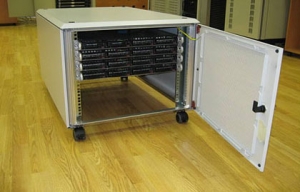 |
Cluster of laboratory or personal level (one bedside table or small rack)
Peak performance of universal processors of one computing node is up to 249.6 GFlops (up to 364.8 GFlops in the first quarter). Up to four four-processor boards with 6-core AMD Istanbul microprocessors are used (hereinafter - with 12-core AMD Magny-Cors and 8-core multi-thread Intel Nehalem-EX);
Part number:
Description
Cluster of laboratory or personal level (one bedside table or small rack)
Peak performance of universal processors of one computing node is up to 249.6 GFlops (up to 364.8 GFlops in the first quarter). Up to four four-processor boards with 6-core AMD Istanbul microprocessors are used (hereinafter - with 12-core AMD Magny-Cors and 8-core multi-thread Intel Nehalem-EX);
DESCRIPTION
Single node RAM up to 256 GB globally addressed within the node;
Scaling (for four nodes) - peak performance up to 1.5 TFlops and 1 TV of RAM;
HDD on one node - up to 3 SATA II 2TB drives;
It is possible to connect accelerators with graphic processors (GPGPU). Peak node performance with GPGPU at double precision up to 1600 GFlops (in the second quarter up to 3 Tflops) The height of nodes with GPGPU is 4U;
External storage system 14-28 TB with support with Global Name Space;
InfiniBand DDR, QDR Interconnect Networks, 10 Gbps Ethernet, 1 Gbps Ethernet;
Power supply 2.5 - 3 kW (from one or two conventional power outlets);
Standard software (Linux, Windows, C, C ++, Fortran, MPI, OpenMP), RDMA libraries (GASNet, ARMCI), parallel compilers DVM-C and DVM-FORTRAN (original Russian developments), parallel programming language Charm ++ based on computational models with message-driven control, PGAS class parallel programming languages (UPC, Co-Array Fortran), as well as the latest promising languages Chapel and X10;
It is possible to install and maintain application software packages of Russian and foreign production for solving problems in the field of engineering, chemistry, biology and pharmaceuticals - Marc, Nastran, Ansys, LS-Dyna, Star-CD, Fluent, FlowVision (Russia), ASONIKA (Russia). In addition, it is possible to install a special library, an original development, for efficient work with unstructured data and development of information systems, as well as a library for solving complex computational problems and data analysis tasks;
Remote administration system with 24/7 support;
The operational uniqueness of the installation lies in the fact that the multiprocessor nodes used have a powerful internal communication network (based on HyperTransport or InfiniPath) connecting processors and common memory modules with high throughput. Thus, one node is a powerful symmetric multiprocessor with shared memory (SMP processor with 16-48 microprocessor cores), which is extremely important in practice for working application packages. In the future, it is planned to use vSMP technology to emulate globally addressed memory for all nodes. Previously, such nodes were used, for example, by IBM and SGI in extremely expensive custom-made supercomputers that were subject to distribution restrictions.
Peak performance of universal processors of one computing node is up to 249.6 GFlops (up to 364.8 GFlops in the first quarter). Up to four four-processor boards with 6-core AMD Istanbul microprocessors are used (hereinafter - with 12-core AMD Magny-Cors and 8-core multi-thread Intel Nehalem-EX);
DESCRIPTION
Single node RAM up to 256 GB globally addressed within the node;
Scaling (for four nodes) - peak performance up to 1.5 TFlops and 1 TV of RAM;
HDD on one node - up to 3 SATA II 2TB drives;
It is possible to connect accelerators with graphic processors (GPGPU). Peak node performance with GPGPU at double precision up to 1600 GFlops (in the second quarter up to 3 Tflops) The height of nodes with GPGPU is 4U;
External storage system 14-28 TB with support with Global Name Space;
InfiniBand DDR, QDR Interconnect Networks, 10 Gbps Ethernet, 1 Gbps Ethernet;
Power supply 2.5 - 3 kW (from one or two conventional power outlets);
Standard software (Linux, Windows, C, C ++, Fortran, MPI, OpenMP), RDMA libraries (GASNet, ARMCI), parallel compilers DVM-C and DVM-FORTRAN (original Russian developments), parallel programming language Charm ++ based on computational models with message-driven control, PGAS class parallel programming languages (UPC, Co-Array Fortran), as well as the latest promising languages Chapel and X10;
It is possible to install and maintain application software packages of Russian and foreign production for solving problems in the field of engineering, chemistry, biology and pharmaceuticals - Marc, Nastran, Ansys, LS-Dyna, Star-CD, Fluent, FlowVision (Russia), ASONIKA (Russia). In addition, it is possible to install a special library, an original development, for efficient work with unstructured data and development of information systems, as well as a library for solving complex computational problems and data analysis tasks;
Remote administration system with 24/7 support;
The operational uniqueness of the installation lies in the fact that the multiprocessor nodes used have a powerful internal communication network (based on HyperTransport or InfiniPath) connecting processors and common memory modules with high throughput. Thus, one node is a powerful symmetric multiprocessor with shared memory (SMP processor with 16-48 microprocessor cores), which is extremely important in practice for working application packages. In the future, it is planned to use vSMP technology to emulate globally addressed memory for all nodes. Previously, such nodes were used, for example, by IBM and SGI in extremely expensive custom-made supercomputers that were subject to distribution restrictions.